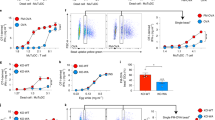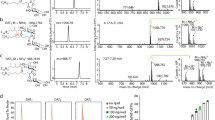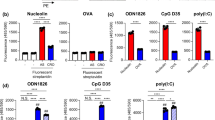Abstract
We analyzed the interaction between a bacterial cell wall protein and dendritic cells (DCs). Outer membrane protein A from Klebsiella pneumoniae (kpOmpA) specifically bound to professional antigen presenting cells and was endocytosed by immature DCs via a receptor-dependent mechanism. kpOmpA signaled through Toll-like receptor 2, induced DCs to produce interleukin 12 and induced maturation of DCs. Whole antigen that was coupled to kpOmpA and injected into mice was taken up by DCs and delivered to the conventional cytosolic MHC class I presentation pathway. kpOmpA also primed antigen-specific CD8+ CTLs in the absence of CD4+ T cell help or adjuvant and elicited therapeutic immunity to antigen-expressing tumors. Thus, OmpA belongs to a class of proteins that are able to elicit CTL responses to exogenous antigen.
This is a preview of subscription content, access via your institution
Access options
Subscribe to this journal
Receive 12 print issues and online access
$209.00 per year
only $17.42 per issue
Buy this article
- Purchase on Springer Link
- Instant access to full article PDF
Prices may be subject to local taxes which are calculated during checkout






Similar content being viewed by others
References
Pamer, E. & Cresswell, P. Mechanisms of MHC class-I restricted antigen processing. Annu. Rev. Immunol. 16, 323–358 (1998).
Watts, C. Capture and processing of exogenous antigens for presentation on MHC molecules. Annu. Rev. Immunol. 15, 821–850 (1997).
Heath, W. R. & Carbonne, F. R. Cytotoxic T lymphocyte activation by cross-priming. Curr. Opin. Immunol. 11, 314–318 (1999).
Yewdell, J. W., Norbury, C. C. & Bennink J. R. Mechanisms of exogenous antigen presentation by MHC class I molecules in vitro and in vivo: implications for generating CD8+ T cell responses to infectious agents, tumors, transplants, and vaccines. Adv. Immunol. 73, 1–77 (1999).
Albert, M. L., Sauter, B. & Bhardway, N. Dendritic cells acquire antigen from apoptotic cells and induce class I-restricted CTLs. Nature 392, 86–89 (1998).
Rodriguez, A., Regnault, A., Kleijmeer, M., Ricciardi-Castagnoli, P. & Amigorena, S. Selective transport of internalized antigens to the cytosol for MHC class I presentation in dendritic cells. Nature Cell Biol. 1, 362–368 (1999).
Schild, H., Arnold-Schild, D., Lammert, E. & Rammensee, H. G. Stress proteins and immunity mediated by cytotoxic T lymphocytes. Curr. Opin. Immunol. 11, 109–113 (1999).
Singh-Jasuja, H. et al. Cross-presentation of glycoprotein 96-associated antigens on major histocompatibility complex class I molecules requires receptor-mediated endocytosis. J. Exp. Med. 191, 1965–1974 (2000).
Binder, R. J., Han, D. K. & Srivastava, P. K. CD91: a receptor for heat shock protein gp96. Nature Immunol. 1, 151–155 (2000).
Kovacsovics-Bankowski, M. et al. Efficient major histocompatibility complex class I presentation of exogenous antigen upon phagocytosis by macrophages. Proc. Natl Acad. Sci. USA 90, 4942–4946 (1993).
Norbury, C. C., Hewlett, J. J., Prescott, A. R., Shastri, N. & Watts, C. Class I MHC presentation of exogenous soluble antigen via macropinocytosis in bone marrow macrophages. Immunity 3, 783–791 (1995).
Kovacsovics-Bankowski, M. & Rock, K. L. A phagosome-to-cytosol pathway for exogenous antigens presented on MHC class I molecules. Science 267, 243–246 (1995).
Ke, Y. & Kapp, J. A. Exogenous antigens gain access to the major histocompatibility complex class I processing patway in B cells by receptor-mediated uptake. J. Exp. Med. 184, 1179–1184 (1996).
Banchereau, J. & Steinman, R. M. Dendritic cells and the control of immunity. Nature 392, 245–252 (1998).
Watts, C. Dendritic cells spill the beans. Nature Cell Biol. 1, 152–154 (1999).
Timmerman, J. M. & Levy, R. Dendritic cell vaccines for cancer immunotherapy. Annu. Rev. Med. 50, 507–529 (1999).
Medzhitov, R. & Janeway, C. A. Innate immunity: impact on the adaptative immune response. Curr. Opin. Immunol. 9, 4–9 (1997).
Rescigno, M. et al. Coordinated events during bacteria-induced DC maturation. Immunol. Today 20, 200–203 (1999).
Lebecque S. Antigen receptors and dendritic cells. Vaccine 25, 1603–1605 (2000).
Muzio, M. et al. Differential expression and regulation of Toll-like receptors (TLR) in human leukocytes: selective expression of TLR3 in dendritic cells. J. Immunol. 164, 5998–6004 (2000).
Albert, M. L. et al. Immature dendritic cells phagocytose apoptotic cells via αvβ5 and CD36, and cross-present antigen to cytotoxic T lymphocytes. J. Exp. Med. 188, 1359–1368 (1998).
Bowie, A. & O'Neill, L. A. J. The interleukin-1 receptor/Toll-like receptor superfamily: signal generators for pro-inflammatory interleukins and microbial products. J. Leuk. Biol. 67, 508–514 (2000).
Muzion, M. & Montovani, A. Toll-like receptors. Microbes Infect. 2, 251–255 (2000).
Su, H. R., Morrison, P., Warkins, N. G. & Cadwell, H. D. Identification and characterization of T helper cell epitopes of the major outer membrane protein of Chlamydia trachomatis. J. Exp. Med. 172, 203–206 (1990).
Wiertz, E. J. et al. Identification of T cell epitopes occurring in a meningococcal class I outermembrane protein using overlapping peptides assembled with simultaneous multiple peptride synthesis. J. Exp. Med. 176, 79–88 (1992).
Poolman, J. T. in Novel Strategies in Design and Production of Vaccines . (eds Cohen, S. & Shafferman, A.) 73–77 (Plenum Press, New York, 1996).
Nguyen, T. et al. Chromosomal sequencing using a PCR-based biotin-capture method allowed isolation of the complete gene for the outer membrane protein A of Klebsiella pneumoniae. Gene 27, 93–101 (1998).
Haeuw, J. F. et al. The recombinant Klebsiella pneumoniae outer membrane protein OmpA has carrier properties for conjugated antigenic peptides. Eur. J. Biochem. 255, 446–454 (1998).
Rauly, I. et al. Carrier properties of a protein derived from the outer membrane protein A of Klebsiella Pneumoniae. Infect. Immun. 67, 5547–5551 (1999).
Sjolander, A. et al. The serum albumin-binding region of streptococcal protein G: a bacterial fusion partner with carrier-related properties. J. Immunol. Methods 14, 115–123 (1997).
Poltorak, A. et al. Defective LPS signaling in C3H/HeJ and C57BL/10ScCr mice: Mutations in TLR4 gene. Science 282, 2085–2088 (1998).
Hirshfeld, M. et al. Cutting edge: Inflammatory signaling by Borrelia burgdorfery lipoproteins is mediated by Toll-like receptor 2. J. Immunol. 163, 2382–2386 (1999).
Lanzavecchia, A. Mechanisms of antigen uptake for presentation. Curr. Opin. Immunol. 8, 348–354 (1996).
Sanderson, S. & Shastri, N. LacZ inductible, antigen/MHC-specific T cell hybrids. Int. Immunol. 6, 369–376 (1994).
Morre, M. W., Carbone, F. R. & Bevan, M. J. Introduction of soluble protein into the class I pathway of antigen, processing and presentation. Cell 54, 777–785 (1988).
Coulie, P. G. et al. A new gene coding for a differentiation antigen recognized by autologous cytolytic T lymphocytes on HLA-A2 melanomas. J. Exp. Med. 180, 35–42 (1994).
Kawakami, Y. et al. Cloning of the gene coding for a shared human melanoma antigen recognized by autologous T cells infiltrating into tumor. Proc. Natl Acad. Sci. USA 91, 3515–3519 (1994).
Bloom, M. B. et al. Identification of tyrosinase-related protein 2 as a tumor rejection antigen for the B16 melanoma. J. Exp. Med. 185, 453–459 (1997).
Valmori, D. et al. Enhanced generation of specific tumor-reactive CTL in vitro by selected Melan-A/MART-1 immunodominant peptide analogues. J. Immunol. 160, 1750–1758 (1998).
Men, Y. et al. Assessment of immunogenicity of human Melan-A peptide analogues in HLA-A*0201/Kb transgenic mice. J. Immunol. 162, 3566–3573 (1999).
Vitiello, A., Marchesini, D., Furze, J., Sherman, L. A. & Chesnut, R.W. Analysis of the HLA-restricted influenza-specific cytotoxic T lymphocyte response in transgenic mice carrying a chimeric human-mouse class I major histocompatibility complex. J. Exp. Med. 173, 1007–1015 (1991).
Rock, K. L. & Clark, K. Analysis of the role of MHC class II presentation in the stimulation of cytotoxic T lymphocytes by antigens targeted into the exogenous antigen-MHC class I presentation pathway. J. Immunol. 156, 3721–3726 (1996).
Sigal, L. J., Reiser, H. & Rock, K. L. The role of B7–1 and B7-2 costimulation for the generation of CTL responses in vivo. J. Immunol. 161, 2740–2745 (1998).
Ridge, J. P., Di Rosa, F. & Matzinger, P. A conditioned dendritic cell can be a temporal bridge between a CD4+ T-helper and a T-Killer cell. Nature 393, 474–483 (1998).
Storkus, W. J. Reversal of natural killing susceptibility in target cells expressing transfected calls I HLA genes. Proc. Natl Acad. Sci. USA 86, 2361–2364 (1989).
Zhou, F., Rouse, B. T. & Huang, L. Prolonged survival of thymoma-bearing mice after vaccination with a soluble protein antigen entrapped in liposomes: a model study. Cancer Res. 52, 6287–6291 (1992).
Sousa, C. R. & Germain, R. N. Analysis of adjuvant function by direct visualization of antigen presentation in vivo: endotoxin promotes accumulation of antigen-bearing dendritic cells in the T cell areas of lymphoid tissue. J. Immunol. 162, 6552–6561 (1999).
Soulas, C. et al. Outer membrane protein A (OmpA) binds to and activates human macrophages. J. Immunol. 165, 2335–2340 (2000).
Underhill D. M. et al. The Toll-like receptor 2 is recruited to macrophage phagosomes and discriminates between pathogens Nature 401, 811–815 (1999).
Freundenberg, M. A. & Galanos, C. Tumor necrosis factor a mediates lethal activity of killed gram-negative and gram-positive bacteria in D-galactosamine-treated mice. Infect. Immun. 59, 2110–2115 (1991).
Seon-Kyeong, K. et al. Induction of HLA class I-restricted CD8+ CTLs specific for the major outer membrane protein of Chlamydia trachomatis in human genital tract infections. J. Immunol. 162, 6855–6866 (1999).
Gromme, M. et al. Recycling MHC class I molecules and endosomal peptide loading. Proc. Natl Acad. Sci. USA 96, 10326–10331 (1999).
Wiedlocha, A. Novel protein toxin-based strategy for development of cytotoxic T lymphocyte vaccines. Arch. Immunol. Ther. Exp. 46, 341–346 (1998).
Acknowledgements
We thank S. Amigorena (Institut Curie) for reviewing the manuscript and N. Shastri (University of California, CA) and L. Sherman (Scripps Institute and research foundation, La Jolla, CA) for providing the B3Z T cell hybridoma and the EL-4/A2Kb cells, respectively. We thank A. Blaecke, J. Challier and A. Gonzalez for technical assistance.
Author information
Authors and Affiliations
Corresponding author
Rights and permissions
About this article
Cite this article
Jeannin, P., Renno, T., Goetsch, L. et al. OmpA targets dendritic cells, induces their maturation and delivers antigen into the MHC class I presentation pathway. Nat Immunol 1, 502–509 (2000). https://doi.org/10.1038/82751
Received:
Accepted:
Issue Date:
DOI: https://doi.org/10.1038/82751
This article is cited by
-
A subunit vaccine against pneumonia: targeting Streptococcus pneumoniae and Klebsiella pneumoniae
Network Modeling Analysis in Health Informatics and Bioinformatics (2023)
-
A novel recombinant protein vaccine containing the different E7 proteins of the HPV16, 18, 6, 11 E7 linked to the HIV-1 Tat (47–57) improve cytotoxic immune responses
Biotechnology Letters (2021)
-
The inflammatory cytokine effect of Pam3CSK4 TLR2 agonist alone or in combination with Leishmania infantum antigen on ex-vivo whole blood from sick and resistant dogs
Parasites & Vectors (2017)
-
The Burkholderia cenocepacia OmpA-like protein BCAL2958: identification, characterization, and detection of anti-BCAL2958 antibodies in serum from B. cepacia complex-infected Cystic Fibrosis patients
AMB Express (2016)
-
Gene polymorphism analysis of Yersinia enterocoliticaouter membrane protein A and putative outer membrane protein A family protein
BMC Genomics (2014)



